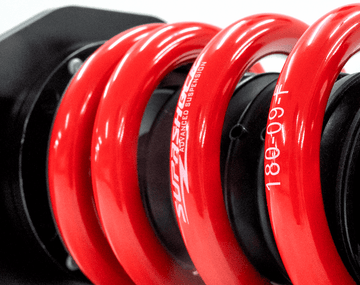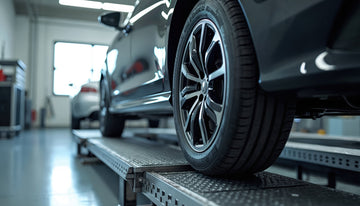Coil springs are essential components of a vehicle's suspension system, serving as a vital link between the vehicle body and the wheels. Designed with a coiled structure, these springs play multiple roles in ensuring optimal performance and comfort while driving.
They perform various functions such as locating and allowing wheel movement, maintaining contact with the road, distributing weight, reducing vehicle weight, resisting steering, braking, and acceleration effects, and collaborating with tires and seat springs for comfortable rides.
Types of Coil Springs: Understanding the Different Varieties for Your Vehicle
There are two main types of coil springs; constant rate coil springs and variable rate coil springs.
Constant coil springs
Constant rate coil springs have a consistent spring rate throughout their compression range. This means that the force required to compress the spring remains relatively constant regardless of the amount of compression. Constant rate springs provide predictable and linear suspension behaviour, offering consistent support and stability.
Variable coil springs
On the other hand, variable rate coil springs have a non-linear spring rate. As the spring compresses, the rate at which it resists compression changes. Variable rate springs are designed to provide different levels of stiffness depending on the amount of compression. They are often used to optimise suspension performance by providing softer initial compression for a smooth ride, and progressively increasing stiffness as the spring compresses further to handle heavier loads or impacts.
Coil Spring Design: Factors that Affect Performance and Durability
The design of coil springs plays a crucial role in their performance and durability. Several factors influence how well a coil spring functions and how long it lasts.
Material Selection: The choice of material, such as high-quality steel alloys, impacts the spring's strength, flexibility, and resistance to fatigue.
Wire Diameter: The diameter of the wire used in the coil affects the spring's stiffness and load-bearing capacity.
Coil Diameter and Pitch: The diameter and pitch of the coils determine the spring's rate, or how much it compresses under a given load.
Number of Active Coils: The number of active coils affects the spring's travel range and overall flexibility.
Heat Treatment: Proper heat treatment processes, such as tempering, can enhance the spring's strength, toughness, and resistance to corrosion.
Stress Relief: Stress relief processes minimise residual stress in the spring, reducing the risk of premature failure.
Coil Spring Maintenance: How to Keep Your Springs in Top Condition
To maintain your coil springs and ensure their optimal performance, you can follow these maintenance tips:
Regular inspection
Periodically inspect your coil springs for signs of damage, such as cracks, corrosion, or sagging. Look for any abnormalities in their shape or condition. If you notice any issues, it's advisable to have them inspected and replaced if necessary.
Cleanliness
Keep your coil springs and the surrounding suspension components clean. Regularly wash away dirt, debris, and road grime that can accumulate and cause premature wear or corrosion. Pay attention to areas where dirt tends to accumulate, such as the coil gaps and spring mounts.
Lubrication
Apply a suitable lubricant to the coil springs, particularly at the contact points with other suspension components. This helps reduce friction, minimise noise, and prevent corrosion. Use a lubricant recommended by the vehicle manufacturer or a specialised suspension lubricant.
Check for loose or worn components
Inspect the entire suspension system, including mounts, bushings, and connectors, for any loose or worn components. Loose or worn parts can affect the performance of the coil springs and lead to premature failure. Replace or repair any damaged or worn-out components as needed.
Be mindful of load limits
Avoid overloading your vehicle beyond its recommended weight limits. Excessive weight can put undue stress on the coil springs, leading to accelerated wear and reduced performance. Follow the manufacturer's guidelines for load capacity to maintain the integrity of the springs and the suspension system as a whole.
Smooth driving
Practise smooth and controlled driving habits to minimise sudden impacts or rough driving conditions. Avoid hitting potholes, speed bumps, or other road irregularities at high speeds. This reduces the stress and strain on the coil springs, helping to prolong their lifespan.
Regular suspension maintenance
Follow the recommended maintenance schedule for your vehicle's suspension system. This may include tasks such as wheel alignment, tire rotation, and balancing, which can indirectly impact the performance and longevity of the coil springs.
Professional inspection
If you suspect any issues with your coil springs or if you notice unusual noises, vibrations, or handling characteristics, have your vehicle inspected by a qualified mechanic or suspension specialist. They can identify any potential problems and recommend appropriate repairs or replacements.
Coil Spring Design: Understanding the Principles Behind Effective Spring Engineering
Coil spring design is a vital aspect of mechanical engineering, rooted in principles of strength, elasticity, and precision. Key to this is Hooke's Law, indicating the direct proportionality between a spring's displacement and the force it exerts. Material selection, be it spring steel or a specialized alloy, impacts the spring's performance attributes like load-bearing capacity and corrosion resistance. Geometrical aspects, including diameter, pitch, and coil count, are also essential, determining the spring's operational characteristics. Heat treatment adds the finishing touches, enhancing durability. These principles blend metallurgical science and precision engineering, crucial for creating robust, reliable springs.





